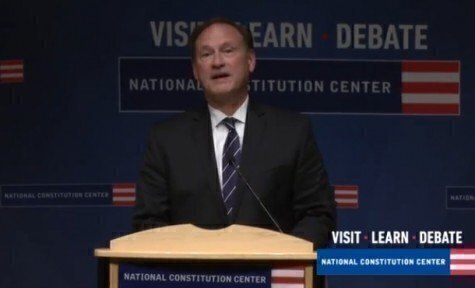Commentator Bill Kristol recently proposed that Supreme Court Justice Samuel Alito enter the Republican presidential race. While that may be the longest of long shots, it does raise some interesting historical points about the Justices as political candidates.

Kristol doesn’t like any of the 17 current GOP presidential candidates. “There are distinguished conservative leaders from outside politics; Justice Samuel Alito and General (ret.) Jack Keane come to mind,” Kristol said on the Weekly Standard with a quick qualifier. “None of them now plans to run. None of them wants to run. None of them may be required to run for the sake of the country. But isn't it worth at this point pushing the door a bit ajar?”
If Alito were to switch careers and win the 2016 election, he would be the first former Supreme Court Justice to serve in the White House. (William Howard Taft joined the Supreme Court after he was President.)
But Alito (or any member of the current Court) wouldn’t be the first sitting Supreme Court Justice to seek political office. And some Justices have taken on extra public duties while serving at the Court.
The Constitution lacks specific restrictions on Supreme Court Justices running for President while sitting on the Court.
For example, John Jay, the first Chief Justice, quit the Supreme Court in 1795 to become the governor of New York state. Jay lost his first election attempt in 1792 in New York, while keeping his Supreme Court seat. So Jay ran twice for elected office without resigning from the Supreme Court.
Another early Justice who ran for political office was the little-known Smith Thompson. He failed in an 1828 to become New York’s governor.
David Davis, who sat on the Supreme Court in 1877, missed a chance of becoming the tie-breaking vote in the contested 1876 presidential election commission when he was appointed as a U.S. Senator from Illinois.
The most famous Justice-turned-candidate was Charles Evans Hughes. In his distinguished public career, Hughes left the Supreme Court in 1916 to challenge Woodrow Wilson for the White House. After a narrow loss, Hughes eventually became Secretary of State, and he served as a United States delegate to the Permanent Court of Arbitration. In 1930, Hughes returned to the Court as Chief Justice of the United States
William O. Douglas also was mentioned in 1944 and 1948 as a possible Vice President candidate while he was sitting as a Supreme Court Justice, while James Byrnes, who briefly sat on the Court during the FDR era, later became governor of South Carolina.
A most-interesting case was Justice Arthur Goldberg, who quit the Supreme Court in 1965 to accept President Lyndon Johnson’s appointment as United States Ambassador to the United Nations. Goldberg left that position in 1968.
In other cases, Supreme Court Justices have taken on important duties in public service while remaining on the bench. Justice Robert Jackson was the Chief United States Prosecutor at the International War Crimes Tribunal in Nuremberg, Germany, after World War II.
Justice Owen J. Roberts headed the investigation into the Japanese attack on Pearl Harbor, while Chief Justice Earl Warren famously headed the commission that investigated the assassination of President John F. Kennedy.






